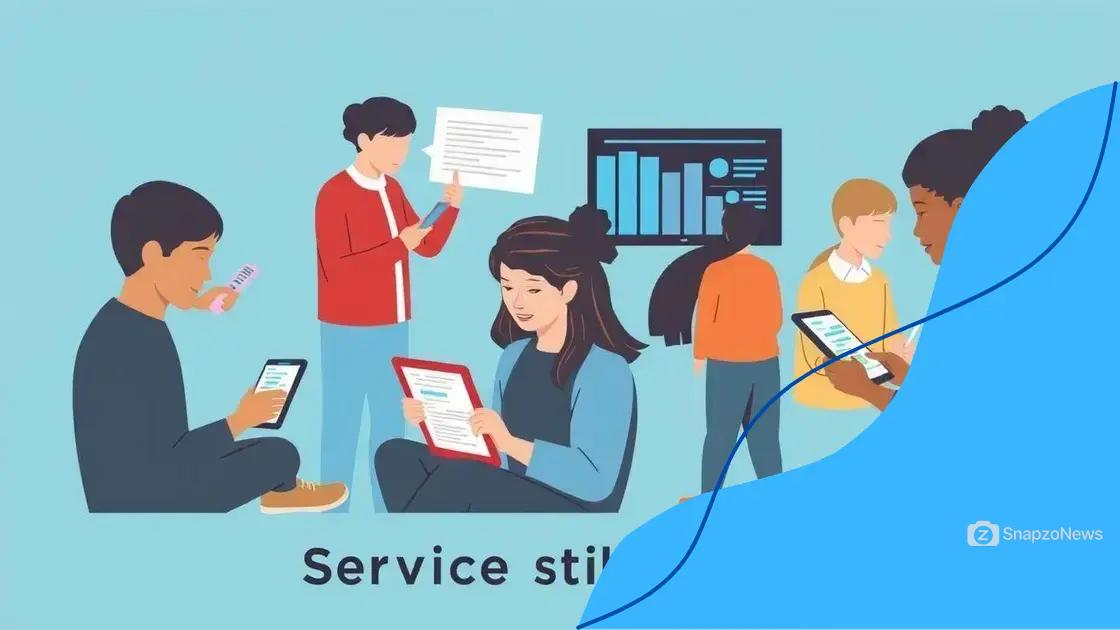Technology’s role in benefit service delivery

Technology plays a vital role in benefit service delivery by enhancing accessibility, improving efficiency through automation and data analytics, and ensuring security with innovations like blockchain and AI.
Technology’s role in benefit service delivery is becoming increasingly significant, reshaping how we access essential services. Have you ever wondered how these innovations simplify your everyday needs? This article dives into the various ways technology is making a real difference.
Understanding technology’s impact on service delivery
Understanding how technology’s impact on service delivery is crucial for both providers and users. As digitally based systems take the forefront, it’s essential to know how they improve interactions and efficiency.
Key aspects of technology in service delivery include accessibility, speed, and tailored experiences. These components help meet the needs of a diverse clientele effectively. They also enhance user satisfaction through smooth and quick processes.
Accessibility and Convenience
One significant benefit of technology is increased accessibility. Many people can now access services from their homes, reducing the need for travel.
- Online applications streamline processes.
- Services are available 24/7, making it easier for users.
- Mobile apps provide information at users’ fingertips.
Moreover, the ability to access services anytime and anywhere helps those with mobility challenges. This is part of what makes technology so impactful in delivering benefits.
Efficiency and Speed
Technology significantly enhances the efficiency of service delivery. Processes that once took hours can now be completed in minutes. For example, automation tools reduce human error and speed up processing times.
These improvements also save time and resources, making organizations more efficient. As a result, they can allocate funds and personnel better, focusing on helping more people.
In addition, technology facilitates better communication between providers and users. Notifications and reminders can be automated, ensuring that no one misses important deadlines.
Key technologies enhancing benefit services
Key technologies significantly enhance benefit services, leading to improved experiences for users. These tools allow organizations to operate more effectively and reach those in need.
Cloud computing is one major technology transforming benefit services. By storing data in the cloud, organizations can access important information anytime, anywhere. This accessibility boosts collaboration and streamlines service delivery.
Data Analytics
Another critical area is the use of data analytics. With data collection, organizations can better understand user needs. Analytics help identify trends and improve service offerings.
- Targeted outreach to specific groups becomes easier.
- Performance data guides resource allocation.
- Service improvements are based on user feedback.
Additionally, artificial intelligence (AI) plays a vital role in automating and personalizing services. AI systems analyze user interactions and can tailor services to meet individual needs, enhancing satisfaction.
Mobile Technology
Mobile technology also elevates access to services. Many users rely on smartphones to receive updates and access benefits on-the-go. This convenience plays a crucial part in reaching wider audiences.
Additionally, chatbots powered by AI offer real-time assistance through mobile apps and websites. These chatbots help users navigate services, answer common questions, and save time.
Integrating blockchain technology is another exciting development. This technology supports secure transactions and maintains privacy, building trust in service delivery. By verifying identities and transactions, blockchain enhances security for all parties involved.
How technology improves accessibility and efficiency

Technology plays a crucial role in how it improves accessibility and efficiency in service delivery. By leveraging various tools, organizations can reach more people and streamline their processes.
Accessible Platforms provide vital pathways for everyone. Online services enable users to access benefits without facing geographical barriers. This keeps essential support within reach for all.
Enhancing User Experience
Users benefit from websites and apps that are designed with accessibility in mind. These platforms often include features like screen readers and multilingual options for diverse audiences.
- Easy navigation improves user satisfaction.
- Adjustable text size and contrast settings help visually impaired users.
- Video content with captions makes information more accessible.
Such advancements not only fulfill legal requirements but also enhance user engagement. This leads to higher satisfaction levels among users.
Streamlining Processes
Technology greatly enhances the efficiency of service delivery processes. Automation tools can handle routine tasks quickly, allowing staff to focus on more critical areas. For example, automated email notifications ensure timely updates for applicants.
Moreover, data management systems track user interactions, identifying bottlenecks and improving service flows. Enhanced data sharing between departments also results in faster response times.
Additionally, virtual assistance tools enable direct interaction between users and services. They can answer questions, guide users through processes, and provide real-time support, making the experience seamless.
Challenges of integrating technology in services
Integrating technology into services presents several challenges that organizations must navigate. While the benefits are clear, the obstacles can impact the overall effectiveness of service delivery.
Cost of Implementation is a major barrier for many organizations. Upfront costs for technology can be high, including software, hardware, and training expenses. Budget constraints often limit what can be achieved, making it difficult to adopt new systems.
Resistance to Change
Another significant challenge is resistance to change among staff. Employees may feel uncertain about new technologies and often prefer familiar processes. This can slow down the integration process, leading to incomplete implementations.
- Training programs are essential to alleviate fears.
- Involvement of employees in decision-making helps increase buy-in.
- Clear communication about the benefits can ease transitions.
Moreover, organizations need to address the issue of legacy systems that may not be compatible with new technology. This can create further complications and delay integration efforts.
Data Privacy and Security
Data privacy and security play a crucial role when integrating technology. As organizations adopt digital solutions, they handle sensitive information that must be protected. Cybersecurity threats are constantly evolving and can jeopardize user trust.
Organizations must invest in robust security measures to safeguard data and maintain confidentiality. Regular updates and employee training about security best practices are vital in this context.
Additionally, compliance with regulations such as GDPR is essential when implementing new technologies. Ensuring that all services adhere to legal requirements can complicate adoption efforts.
Future trends in technology for benefit delivery
Future trends in technology for benefit delivery are set to transform how services are provided. As advancements in technology continue to emerge, they bring new opportunities and challenges.
Artificial intelligence (AI) is at the forefront of these trends. Organizations are increasingly using AI to analyze data, personalize services, and improve decision-making processes. This technology enhances operational efficiency and user experience.
Enhanced User Interfaces
Another trend is the development of enhanced user interfaces. Intuitive design helps users navigate services with ease. Features like voice commands and chatbots enable seamless interaction, making it easier for individuals to access the services they need.
- User-friendly mobile apps offer on-the-go access.
- Visual dashboards provide real-time data insights.
- Customized notifications ensure users don’t miss important updates.
As these interfaces evolve, they prioritize accessibility, ensuring that everyone can utilize services effectively.
Blockchain Integration
Blockchain technology is also becoming a significant trend. It provides secure and transparent transactions, which is especially beneficial in service delivery. With blockchain, organizations can ensure the integrity of data while safeguarding user privacy.
This technology can simplify processes like identity verification and claims processing, leading to faster service delivery. Moreover, increased security measures help build trust among users.
The growth of data analytics will further complement these trends. Leveraging big data enhances insights into user behavior and service needs. By understanding trends and preferences, organizations can tailor services to meet evolving demands.
FAQ – Frequently Asked Questions about Technology’s Role in Benefit Service Delivery
How can technology improve service accessibility?
Technology enhances service accessibility by allowing users to access services online, thus removing geographical barriers and enabling better access for everyone.
What role does artificial intelligence play in service delivery?
Artificial intelligence helps personalize services, analyze user data, and improve operational efficiency, making it easier to meet the specific needs of users.
What are some challenges of integrating new technology?
Challenges include high implementation costs, resistance to change from staff, and the need to ensure data privacy and cybersecurity.
How will future technology trends impact benefit delivery?
Future trends like AI, blockchain, and enhanced user interfaces will streamline processes, increase security, and improve overall user satisfaction.
